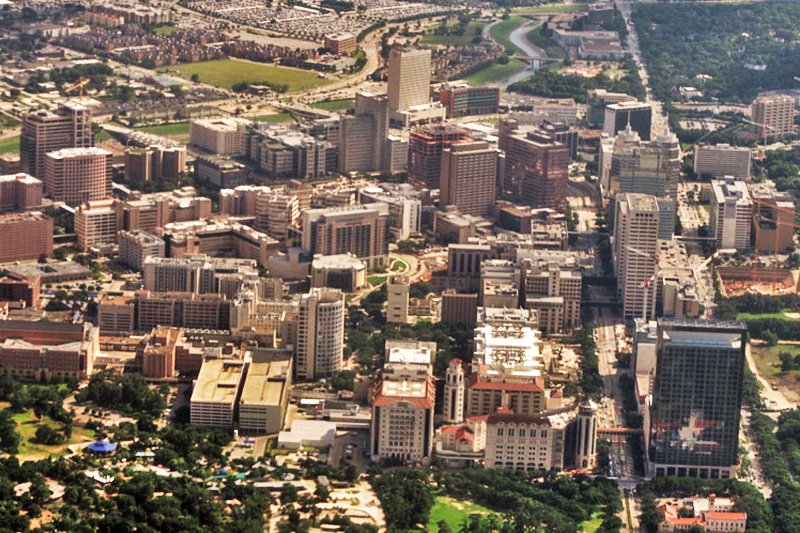Since the first time I went to MD Anderson Cancer Center for work, I’ve been impressed by the large scale of medicine in Houston. Walking through the area around MDA, building after building was a hospital or specialty care center of some kind. While the scale is impressive, I’ve wondered why all these institutions were located seemingly on top of one another. On my most recent trip to Houston, I got the answer: Texas Medical Center.
What is the Texas Medical Center (TMC)?
In 1936, Monroe Dunaway Anderson used some of the wealth he built in the cotton business to set up a charitable trust. Three years later, Anderson passed away and the MD Anderson Foundation came into an additional $19 million. Over the next couple of years, the Foundation bought 134 acres of land and provided funding to both a cancer research hospital and Baylor College of Medicine, helping them to locate in Houston. (Historical overview via Hope for Growth and Community) These days TMC includes 54 member organizations, 1,300 acres, 2,800 buildings and more square footage than downtown Houston.
TMC is interesting beyond scale. Because of the business model spelled out in the TMC charter, the high quality institutions involved and the collaborations that result. Due to the charitable nature of the TMC, the business model is different than many similar types of economic development projects in other metro areas. TMC provides low cost land to attract non-profit health organizations with an academic bent. Another component of the TMC mission is to provide a conduit for collaboration between organizations, an expectation for incoming TMC members. Since there are over two dozen health-related institutions and over half a dozen academic institutions, overlap at has the potential to spark innovation. Sharing of teaching resources between the member organizations is another area of collaboration. I recently met Sendurai Mani, an Assistant Professor at MD Anderson, who studies the impact of epithelial-mesenchymal transition in the progression of cancer. In addition to his work at MD Anderson, Mani is also involved in programs at The University of Texas Graduate School of Biomedical Sciences and Baylor College of Medicine.
TMC: Getting Beyond Physical Infrastructure?
When I see large institutions such as TMC, I am curious how they will grow, perhaps not in size but in scope. In late 2012, TMC Corporation got a new President & CEO, Dr. Robert Robbins who was and chairman of the Department of Cardiothoracic Surgery at Stanford and director of the Stanford Cardiovascular Institute. I came across an interview from January 2013 with Dr. Robbins and Houston Business Journal that suggests where the priorities at TMC are headed.
“Where I really want to focus my energy is to look for programmatic infrastructure that could add value to the overall Texas Medical Center, whether that be in the area of innovation and discovery, whether that’s in genomics, health policy, in terms of clinical trials or other more basic science things like regenerative medicine. Those are the big areas that I hope to focus on.” TMC Corporation President & CEO Dr. Robert Robbins
TMC & Houston Are Stepping Out
Economic development activities often include recruiting trade shows to the local area or targeting trade shows to showcase areas of strength. Houston has recently decided on a different approach: developing a new conference. Messe Dusseldorf is an organization in Germany that has taken a similar approach, leading to one of the largest international medical conferences, MEDICA, which attracted 130,600 attendees from 120 countries in November 2012. For perspective, the Biotechnology Industry Organization International Convention in Boston in June of 2012 attracted 16,505 attendees. A group of Houston-based organizations has partnered with Messe Dusseldorf to develop the Medical World Americas conference that will launch in April 2014. The organizations collaborating include the Texas Medical Center (TMC) as well as a variety of groups interested in economic development and tourism: Greater Houston Convention and Visitors Bureau, the Greater Houston Partnership, Houston First and the City of Houston. Given that the TMC is only five miles from the convention center, there should be plenty of opportunity to showcase the strengths of TMC to attendees.
Houston Tidbits
I didn’t know that much about Houston so here are some fast facts for context.
- Houston is home to about 2.1 million people with 5.95 million residents in the metro area, making the city the sixth largest US metro statistical area.
- Houston is home to more than 5,000 energy related companies. However, the economy is diverse, with nearly half of the jobs in Houston unrelated to energy.
- The Port of Houston is the largest US port in international tonnage and is second by total tonnage.
- Houston has one of the ten largest convention centers in the country.



Laura, it’s clear you were quite impressed. But you know as well as I that some- too many- will be dismissive of anything from Texas, based on cultural or political perceptions and preconceived notions. Here in the Northeast you can almost cut the arrogance and sense of superiority with a knife.